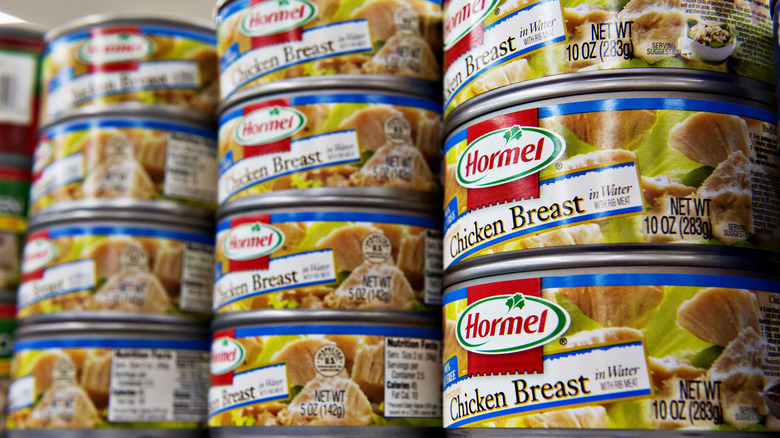Is It Safe To Eat Pink Canned Chicken?
With its incredible convenience and endless versatility, canned chicken has become a certified canned food pantry staple, and rightfully so. It provides a great source of protein that can be easily incorporated into various dishes, from salads and sandwiches to soups and casseroles. It even makes a great filling for chicken pot pie! As reliable as canned chicken is, it can sometimes take on a somewhat dubious appearance. Regardless of how it's prepared, canned chicken often appears to have a pinkish hue that makes it seem worryingly undercooked. But if you have ever doubted the safety of rosy-colored chicken, fear not — it is completely safe to eat.
Canned chicken is typically cooked and preserved using high temperatures during the canning process, which helps to kill bacteria and pathogens, ensuring it's safe for consumption. The pink tint is just a natural feature of cooked chicken. According to the USDA, it is acceptable and almost expected for canned chicken to be a bit pinkish when the can is first cracked open. After being left to sit out for several minutes, the chicken should take on a less raw appearance.
The science behind pink chicken
There are a few factors that can contribute to canned chicken's color. Usually, the primary culprit behind pink coloration is a protein called myoglobin. Myoglobin is present in muscle tissues and is what makes meat red. Per the USDA, "when it is mixed with oxygen, it becomes oxymyoglobin and produces a bright red color." Cooked chicken can also retain traces of hemoglobin, a component of red blood cells. Additionally, depending on what the chickens ate, nitrates or nitrites may also contribute to pink canned chicken, as well as additives or preservatives used in the canning process.
Elements like an animal's age and activity level can also affect the color of its meat. Old muscles will have more myoglobin, which means more color, while muscles that have been worked out a lot appear naturally darker. Pink coloration or shifting hues is a normal feature of many kinds of meat, and is not in itself an indication that something has gone off. This goes for both shredded and chunky canned chicken. However, there are a few pinky-red flags you should look out for to identify spoiled canned chicken.
How to tell if canned chicken has gone bad
Several indicators can help determine if canned chicken's pink color is a side effect of deterioration. First, examine the can for any signs of damage, such as dents, bulges, or rust. Damaged cans may compromise the integrity of the packaging and allow germs and other foreign substances in, rendering the chicken unsafe to eat. If the can looks good, smell the chicken for any unusual odors. A sour or putrid smell is never a good sign. Also, look at the texture of the chicken. If it appears slimy, sticky, or discolored, it is likely spoiled and should be discarded. While a pink tinge alone may not signify spoilage, other concerning colors in the chicken, such as green or gray patches, are definite red flags that indicate mold or bacterial growth.
Finally, check for any foamy or cloudy liquid that may be present when you open the can. When in doubt, it is always better to err on the side of caution and discard any canned chicken that makes you second guess its quality. Eating underdone meat is extremely dangerous, so it's easy to see why pink canned chicken may give someone pause. But by understanding the reasoning behind this blush, you can enjoy your on-the-go chicken salad in peace.


